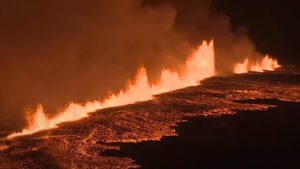 The long-awaited eruption began on Iceland’s Reykjanes Peninsula yesterday evening. At 10:17 p.m. an approximately 4 km long eruption fissure opens between Stóra-Skógfell and the old Sundhnúkar crater series. Lava fountains shoot up to 100 m high. The delivery rate is estimated at 100 – 200 cubic meters per second. The flow speed is just under 1 km per hour. The distance from the southern end to the outskirts of Grindavík is almost 3 km.
The long-awaited eruption began on Iceland’s Reykjanes Peninsula yesterday evening. At 10:17 p.m. an approximately 4 km long eruption fissure opens between Stóra-Skógfell and the old Sundhnúkar crater series. Lava fountains shoot up to 100 m high. The delivery rate is estimated at 100 – 200 cubic meters per second. The flow speed is just under 1 km per hour. The distance from the southern end to the outskirts of Grindavík is almost 3 km.
The volcanic eruption was preceded by a seismic crisis that began 90 minutes before the eruption. The IMO tables show 538 shocks, the period again being 48 hours. A good 300 earthquakes occurred immediately before the eruption. If you look at the size of the fissure, there were very few earthquakes and the warning time was short. It can be assumed that the melt was less than 1 km below the surface. It had already risen to this depth shortly after the dyke intrusion on November 10th. Apparently later, the volcanologists’ assessments were incorrect that most of the melt in the dyke had solidified after just 2-3 weeks. There were probably no measurable magma movements because the pressure in the dyke was too great.